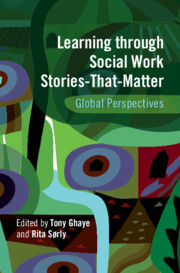Book contents
- Learning through Social Work Stories-that-Matter
- Learning through Social Work Stories-that-Matter
- Copyright page
- Contents
- Meet the Editors
- Meet the Contributors
- Preface
- Acknowledgements
- Introduction
- Part I Storying-to-Learn: How Stories-that-Matter Help Us Appreciate Social Work in Action
- Part II Lenses and Lessons
- Index
- References
Part II - Lenses and Lessons
Towards More Global Perspectives
Published online by Cambridge University Press: 28 August 2025
- Learning through Social Work Stories-that-Matter
- Learning through Social Work Stories-that-Matter
- Copyright page
- Contents
- Meet the Editors
- Meet the Contributors
- Preface
- Acknowledgements
- Introduction
- Part I Storying-to-Learn: How Stories-that-Matter Help Us Appreciate Social Work in Action
- Part II Lenses and Lessons
- Index
- References
Summary
Part II of this book is deliberately called "Lenses and Lessons: Towards more Global Perspectives" as it takes the reader on a journey from Pacific social work across to East Africa and into Europe. It explicity acknowledges the interdependence of the local with the global and that social work is a profession which is shaped by and in turn shapes these geopolitical and socioeconomic contexts. Framed by multiple global crises such as wars in Ukraine and the Middle East, a once-in-a-century pandemic, widespread economic turmoil, a reckoning on race, mass illegal migration, rising inequality, post- and anti-colonial views on social work and much more, the reaffirmation of positive and purposeful and socially relevant social work is illuminated and justified. The issues in Part II can be set against the International Federation of Social Workers definition of social work as “a practice-based profession and an academic discipline that facilitates social change and development, social cohesion, and the empowerment and liberation of people.” In Part II there are implications for social work education, practices, and policy.
Keywords
Information
- Type
- Chapter
- Information
- Learning through Social Work Stories-That-MatterGlobal Perspectives, pp. 311 - 364Publisher: Cambridge University PressPrint publication year: 2025
References
References
References
References
References
References
Accessibility standard: Inaccessible, or known limited accessibility
Content Navigation
Allows you to navigate directly to chapters, sections, or non‐text items through a linked table of contents, reducing the need for extensive scrolling.
Provides an interactive index, letting you go straight to where a term or subject appears in the text without manual searching.
Reading Order & Textual Equivalents
You will encounter all content (including footnotes, captions, etc.) in a clear, sequential flow, making it easier to follow with assistive tools like screen readers.
You get concise descriptions (for images, charts, or media clips), ensuring you do not miss crucial information when visual or audio elements are not accessible.
You get more than just short alt text: you have comprehensive text equivalents, transcripts, captions, or audio descriptions for substantial non‐text content, which is especially helpful for complex visuals or multimedia.
Visual Accessibility
You will still understand key ideas or prompts without relying solely on colour, which is especially helpful if you have colour vision deficiencies.
You benefit from high‐contrast text, which improves legibility if you have low vision or if you are reading in less‐than‐ideal lighting conditions.
